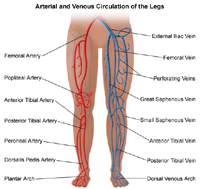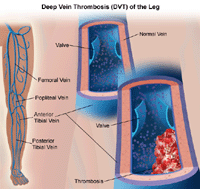Deep Vein Thrombosis (DVT) / Thrombophlebitis
What is deep vein thrombosis?
 |
| Click Image to Enlarge |
Deep vein thrombosis (DVT) occurs when a blood clot develops in a vein deep in the body. Deep veins are found within groups of muscles. The veins close to the skin are called superficial veins.
While these clots most often develop in the lower legs or thighs, they may appear in the upper body, such as the arms or other locations in the body. Deep vein thrombosis is a risk after any major surgery, but patients who have surgery of the legs or hips are at higher risk.
Deep vein thrombosis can pose a serious threat to health. Pieces of a clot can break off and travel through the bloodstream to the lungs. This is called a pulmonary embolism and can be fatal soon after it occurs. Deep vein thrombosis can also block blood flow in the veins, causing the blood to pool. This can cause swelling, pain, and permanent damage to the leg called post-thrombotic syndrome.
 |
| Click Image to Enlarge |
What is thrombophlebitis?
When a clot forms in a vein, inflammation of the vein may occur at the affected site. This is referred to as thrombophlebitis. Inflammation may be minimal, or may be more pronounced, causing swelling, redness, warmth, and tenderness at the site. When thrombophlebitis occurs, the body's response to inflammation may promote the formation of more clots.
What are the risk factors for deep vein thrombosis?
A risk factor is anything that may increase a person's chance of developing a disease. It may be an activity, diet, family history, or many other things.
Although these risk factors increase a person's risk, they don't necessarily cause the disease. Some people with one or more risk factors never develop the disease, while others develop the disease and have no known risk factors. Knowing your risk factors for any disease can help to guide you into the appropriate actions, including changing behaviors and being clinically monitored for the disease.
Risk factors related to or that may contribute to deep vein thrombosis and thrombophlebitis include, but are not limited to:
What causes deep vein thrombosis?
There are a variety of factors that contribute to the development of deep vein thrombosis:
-
Surgery, particularly surgery of the hip or leg, or abdominal surgery
-
A long period of bed rest or sitting for a long time (for example, on an airplane or in a car)
-
Hormones taken for symptoms of menopause
-
Certain diseases and conditions, such as:
-
Varicose veins
-
Chronic atrial fibrillation
-
Inflammatory bowel disease
-
Lupus erythematosus, a disease of the immune system
-
Cancer
-
Heart failure
-
Heart attack
-
Arterial disease
-
Spinal cord injury and resulting paralysis
-
Previous blood clot (thrombosis)
-
Pregnancy
-
Intensive care treatment involving placement of a central venous catheter
-
People with cancer receiving chemotherapy
What are the symptoms of deep vein thrombosis?
Deep vein thrombosis occurs without symptoms about 50 percent of the time. When symptoms do occur, they may include:
-
Swelling in the leg
-
Red, discolored, or white skin
-
A cord in a leg vein that can be felt
-
Rapid heart beat (tachycardia)
-
Slight fever
-
Warm skin
-
More visible surface veins
-
Dull ache, tightness, tenderness or pain in the leg (these symptoms may only occur while walking or standing)
The symptoms of deep vein thrombosis may resemble other medical conditions or problems. Always consult your physician for a diagnosis.
How is deep vein thrombosis diagnosed?
In addition to a complete medical history and physical examination, diagnostic procedures for deep vein thrombosis may include:
-
Duplex ultrasound. This involves using high frequency sound waves to look at the speed of blood flow, and the veins. Occasionally a blood clot may be visualized by ultrasound. This procedure is noninvasive (the skin is not broken) and involves placing ultrasound gel on the affected area and then moving a handheld device across it. A picture of the blood flow is displayed on a monitor. Duplex ultrasound is the most commonly performed diagnostic test for DVT.
-
Magnetic resonance imaging (MRI). This diagnostic procedure uses a combination of large magnets, radio frequencies, and a computer to produce detailed images of organs and structures within the body, and is particularly effective in diagnosing deep vein thrombosis in the pelvis.
-
Venogram. This uses X-rays and intravenous (IV) contrast dye to visualize the veins. Contrast dye causes the blood vessels to appear opaque on the x-ray image, allowing the physician to visualize the blood vessels being evaluated.
What is the treatment for deep vein thrombosis?
Specific treatment will be determined by your physician based on:
-
Your age, overall health and medical history
-
Extent of the disease
-
Your signs and symptoms
-
Your tolerance for specific medications, procedures, or therapies
-
Expectations for the course of the disease
-
Your opinion or preference
The goal of treatment is to prevent the clot from growing, to ensure that it doesn't break off and travel through the veins to the lungs, and to help reduce the possibility of another blood clot forming.
Treatment may include:
-
Medications. Various types of medications may be used in the treatment of DVT. Although anticoagulants (blood thinners) don't destroy the clots, they may keep the clot from growing and other clots from forming. Warfarin (Coumadin) may be taken orally or a heparin injection may be given either intravenously (IV) or under the skin (subcutaneously). Treatment with blood thinners may last from three to six months. If a blood clot develops after surgery, treatment may be shorter. If there have been previous clots or treatment for another illness is underway, the treatment may last as long as risk factors are present.
The most common side effect of blood-thinning medication is bleeding. Bruising or bleeding should be reported to the physician right away.
Another type of medication called fibrinolytics or thrombolytics ("clot busters") can dissolve a clot quickly, over a period of a few days. Fibrinolytics are used in certain situations as determined by a physician.
Thrombin inhibitors are medications that can disrupt the formation of a clot. Patients who can't take heparin may be given one of these medications.
-
Vena cava filter. In some cases, a vena cava filter may be inserted into the vena cava (the large vein which returns blood from the body to the heart) of patients who can't take medication or if blood thinners aren't working. The filter is a kind of "clot catcher."
How can deep vein thrombosis be prevented?
Preventing deep vein thrombosis is important to prevent pulmonary embolism, which can lead to serious complications.
Anticoagulant medications, such as heparin or fondaparinux, may be given to certain surgical patients to prevent deep vein thrombosis after the risk of surgical bleeding has subsided. Those patients who have had a previous clot should follow the instructions of their physician.
Preventing deep vein thrombosis caused by long periods of sitting or reclining involves moving the lower leg. Flexing (bending) the knees may be helpful.
When you travel and must sit for longer than four hours, the National Heart, Lung and Blood Institute (NHLBI) suggests you:
-
Walk up and down the aisles (if traveling by plane or bus)
-
Stop about every hour and walk a little (if traveling by car)
-
While sitting, stretch your feet and move your legs
-
Wear loose clothing
-
Avoid alcohol
-
Drink plenty of fluids
Other preventive measures may include:
-
Getting up and moving as soon as possible after surgery or illness, as movement can help to prevent clots from forming by stimulating blood circulation
-
A pneumatic compression device, which looks like a special fitted sleeve, placed on the legs to help keep blood moving during some types of surgery
-
Elastic stockings to reduce swelling and promote circulation
Consult your physician for diagnosis and treatment.